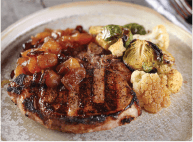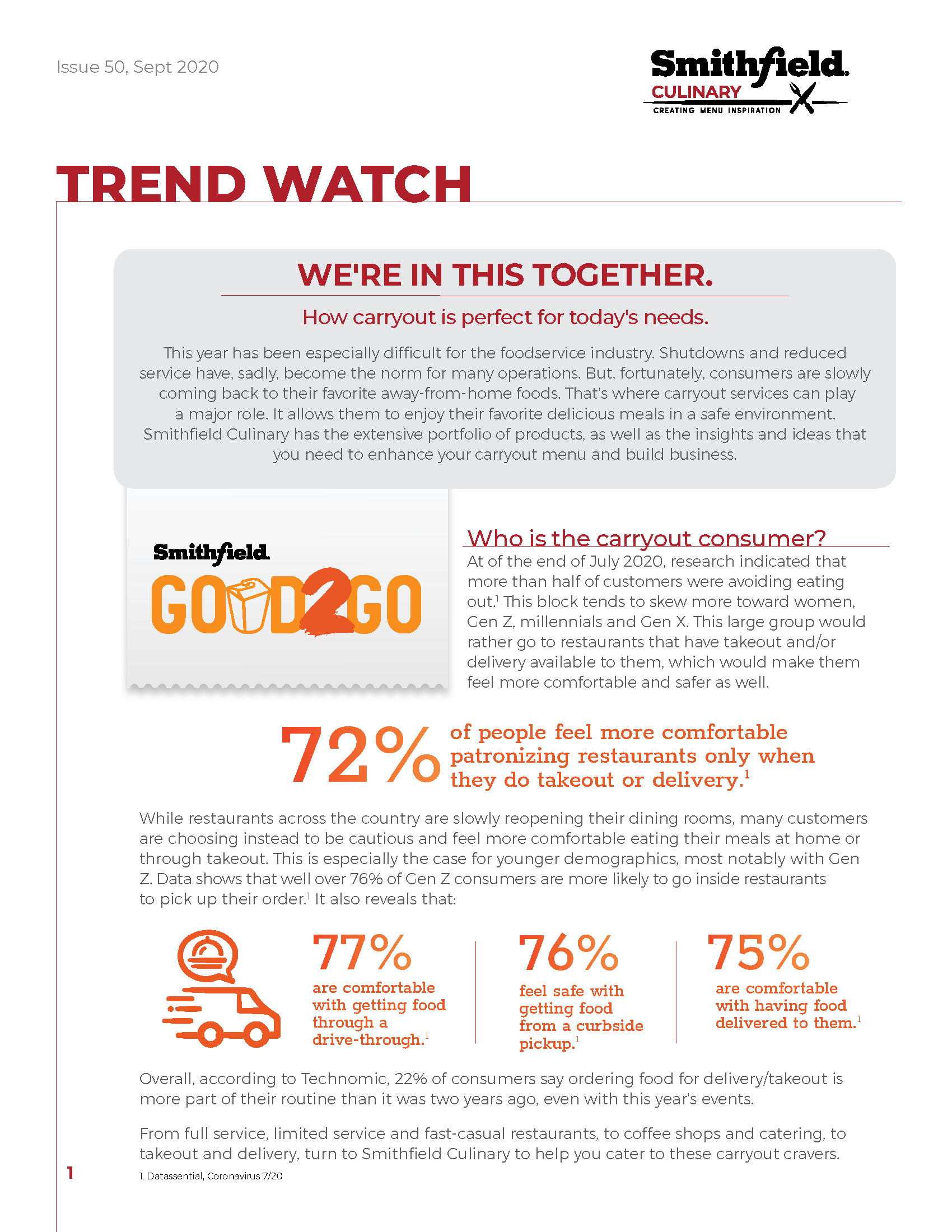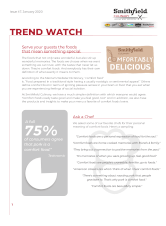TREND WATCH

Enter into the world of today’s most famous pitmasters.
Just about everybody loves BBQ. Diving into a plate of sweet, saucy ribs. Chomping into a pulled pork sandwich. Enjoying a scrumptious plate of barbecued Korean tacos. And BBQ is a trend that just continues to trend. Today, foodservice operators are constantly looking for ways to differentiate their BBQ offerings to keep up with changing consumer appetites, evolving it into different and unique forms to keep up with BBQ-lovers’ demands for more.
According to Datassential, a full 47% of consumers eat pork at least once a week. And pork that’s grilled is the consumer favorite. Partly because it’s a healthier option that still provides great taste.
When it comes to BBQ, nobody has the insights, ideas and recipes you need to build your business more than today’s top pitmasters. Hearing them share their points of view can give operators an edge over the competition when it comes to everything BBQ. So whether you’re already a BBQ restaurant looking to add new and unique offerings, or you’re just looking to add quick and convenient BBQ options to your non-BBQ menu, the following trends and insights could help you build additional business.
Barbeque Means Pork
According to Technomic Center of the Plate, pork is still the consumer favorite protein for BBQ. Other pork facts include:
The top 3 pork entrées are BBQ proteins:
Ribs
and pulled pork
The leading preparation method for pork is barbecued. The top 3 BBQ pork preparations are:
 42%
42%GRILLED
 42%
42%BARBECUED
 50%
50%SMOKED
(Younger consumers 33%)
Consumer BBQ flavor preferences:
SWEET/HONEY
(Sweet is in!)
HICKORY
(The #1 wood)
SMOKY
(Skews younger)
SPICY
(Think ethnic)
CHIPOTLE
(Trending)
Tips from the Pits – Secrets from the Masters
Smithfield gathered renowned pitmasters, all with an extensive foodservice expertise, from around the country to discuss the techniques they apply in creating traditional and on-trend BBQ, such as handheld and fusion.
Smoke: “The word ‘smoke’ immediately conjures an aura of higher BBQ quality. It gives operators permission to charge premium prices on those menu items. Consumers, particularly university students I see, are more than willing to pay more, simply because it includes ‘smoke’ in the name.” – Ernest Servantes
Quick smoking: “There’s no need to over-smoke your BBQ. It’s just as effective to smoke your meat to the desired flavor for a few hours and then simply finish on the stove. It saves both BOH time and customer wait time.” – Tuffy Stone
Sauces: “Start with a sauce you like; add another component like fruit or something with heat. For instance, I’ve got my BBQ sauce, and I’m adding blackberry-jalapeño jam.” – Sterling Ball
What’s Trending? “To keep menus fresh, operators will prepare classic cuts multiple ways. For example, pork butt roasted in the oven can be of-fered as a comfort food special or, alternately, shaved thin as Philly pork.” – Darren Warth
Get Prepared…Differently
- Low-and-slow-cooked barbecue such as brisket, pork shoulder and pork ribs along with pulled pork and beef have been trending in restaurants, even appearing in fast-casual barbecue concepts.
- One key area of innovation for barbecue is that more barbecue restaurants are leveraging different preparation methods and highlighting those details on the menu. Preparation variety in barbecue-based restaurants has increased 9 percent in menu mentions, slow-smoked preparation has increased 11 percent, andslowly cooked as a prep method has noted triple-digit growth.
- Technomic expects to see a proliferation of underused beef and pork cuts, such as shin, leg and collar, cooked in the low-and-slow style. Ethnic pork renditions such as Korean barbecue tacos and pork char siu are also expected to grow.
Changing Tastes
 BBQ lovers with adventurous tastes are always on the lookout for new and different. That’s why operators are constantly updating their menus with the latest trends, such as seasonality, specials, different dayparts, ethnic ingredients, and more. According to FSR:
BBQ lovers with adventurous tastes are always on the lookout for new and different. That’s why operators are constantly updating their menus with the latest trends, such as seasonality, specials, different dayparts, ethnic ingredients, and more. According to FSR:
Gold Standard
The classics, whole hog, pork shoulder, brisket barbecued chicken and others will continue to be prime choices for customers.
Smokin’ Sides
Pitmasters pay more attention to sides by composing dishes, smoking ingredients and moving from canned to housemade.
Cultural Twists
Traditional barbecue gains an uptick in influences from Mexico and Korea in brisket tacos and Asian-spiced ribs.
New Meats
Pitmasters utilize their smoker for pork chops, prime rib, duck, goose and tenderloin, as well as other more unexpected cuts.
Fine Dining
Barbecue heads toward composed plates, variations in sauces, and meats that are more expensive and more obscure cuts.
What’s New on the Menu?
Consumers have long been familiar with Americanized versions of Chinese dishes. But now BBQ lovers have an opportunity to sample Asian-inspired versions of BBQ, including Thai, Vietnamese, Japanese and Korean cuisines. Here are a few unique recipes popping up on U.S. menus.
 Pok Pok
Pok PokEmerging chain Pok Pok features Vietnamese-style pork in its dish, Ju Pa Bao, which includes a Macanese-style bun and a bone-in pork loin fried in pork fat.
 Fine Gyu-Kaku Japanese BBQ
Fine Gyu-Kaku Japanese BBQWith an extensive BBQ menu, Gyu-Kaku, a U.S. chain, of-fers Japanese pork sausages served with cheese fondue or garlic butter.
1. Ethnic food and beverage CTR, 2018
2. QSRMagazine.com
3. Technomic, Flavor consumer trend report, 2017
To discover what Smithfield can do to satisfy the handheld cravings of your customers while building business for you, contact a Smithfield sales representative or call 888-327-6526.



